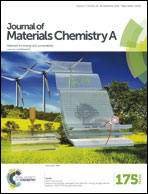Dual-defective strategy directing in situ assembly for effective interfacial contacts in MoS2 cocatalyst/In2S3 light harvester layered photocatalysts†
Abstract
Defective MoS2 nanosheets have been demonstrated to be a superior catalyst for hydrogen evolution; however, mediocre interfacial contact between the MoS2 cocatalyst and the light harvester still impedes the pursuit of composite photocatalyst systems with highly efficient performance. Herein, we propose a dual-defective assembly methodology following the chemical similarity principle to construct effectively-binding MoS2/In2S3 photocatalysts, in which luxuriant defects on layered In2S3 nanosheets serve as in situ growth sites for defective MoS2 layers with abundant exposed edges. The resulting dual-defective system is endowed with improved separation of electron–hole pairs, beneficial interfacial migration and utilization of electrons, and decreased photocorrosion from holes. By this method, the system achieves dramatically enhanced hydrogen evolution activity as well as considerable stability. The imperfections in both MoS2 and In2S3 are indispensable for desirable performance. The present strategy can not only direct the manufacture of defective MoS2-incorporated photocatalysts but may also contribute to the design of other highly active cocatalyst/light harvester systems with effective interfacial contacts.


 Please wait while we load your content...
Please wait while we load your content...